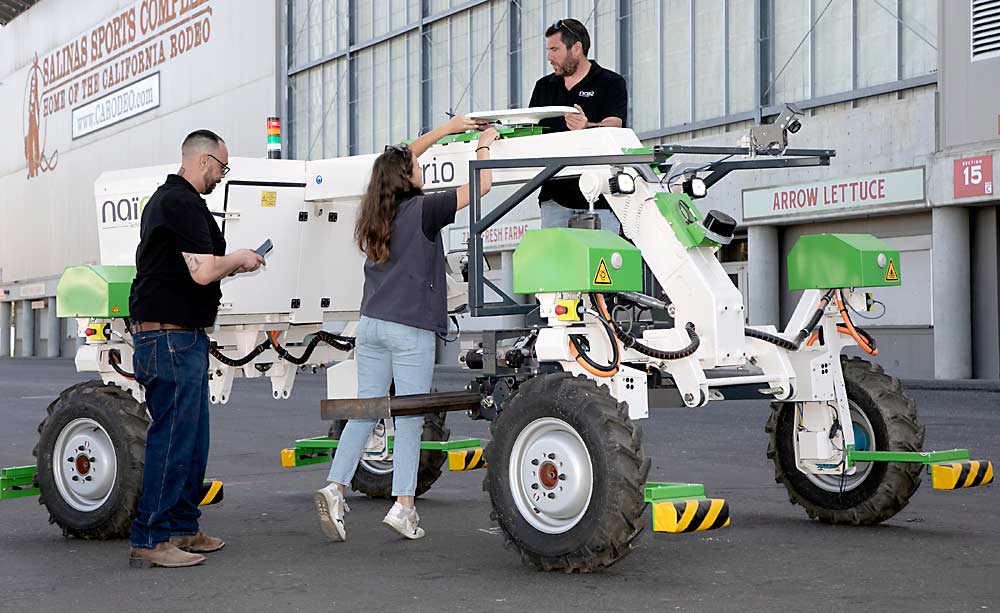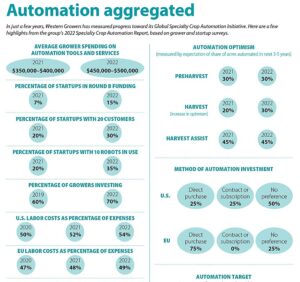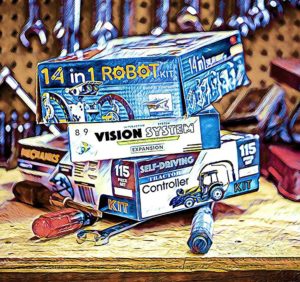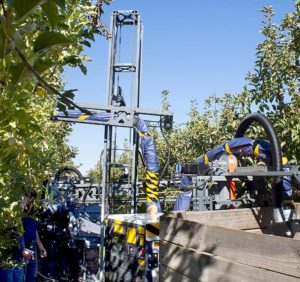

Labor remains one of the biggest challenges in specialty crop agriculture. The problem is due to a domestic workforce that is shrinking, an immigrant workforce that is not growing nearly fast enough to make up the domestic gap and higher costs due to transportation and housing costs for H-2A guest-worker labor. These all combine to make the availability and cost of labor a growing problem.
In 2021, Western Growers launched the Global Harvest Automation Initiative, with partners including the Washington Tree Fruit Research Commission, to help solve this issue. This year, the initiative has been re-branded as the Global Specialty Crop Automation Initiative to acknowledge that it is about much more than just harvest. Western Growers launched several strategic automation projects to support the overall initiative.
Annual automation reports
First, an annual automation report was developed and provides analysis of the global labor market, the automation solutions at both early and later stages of development and the impact the innovators (startups and others) are making with automation solutions. Companies’ progress — in terms of growth in fundraising, robots in the fields and markets entered — is tracked and verified.
In Year 2, the report did a deep dive on the impact of H-2A labor, controlled-environment agriculture and how the European market compares to North America. We also included the 2022 Crop Robotics Landscape, which took a deep look at the automation solutions by segment. (See “Ag automation’s book of numbers.”) The next report in 2024 will include an analysis of manufacturing partners, channel dealer partners (i.e., equipment dealers) and potential investor partners.
Images at the ready
Second, we built an image library that provides a ready-made set of images for key specialty crops. This helps reduce the cost of initial R&D and prototyping by allowing startups to download an image set and begin working instantly, saving startups months and tens to hundreds of thousands of dollars by not requiring them to build their own image library. The image library is open-source and free.
As of June, there were five crops in the image library and 360 library downloads. Going forward, we will be regularly adding new crops and tracking the downloads. We will also be reaching out to library users to confirm the value the images are creating for startups and innovators and get input on things we can do to enhance the image library product.
Crop-specific background for startups
Third, a startup AgTech Toolkit was launched to provide startups with key data for the crop they are working on. It answers questions such as: What is the size of the market? What is the primary use case and the main edge cases and industry integration issues that need to be solved? What are the economics the solution needs to meet to work for growers?
As of June, the startup toolkit had pages for apples and romaine; new crops will be added regularly. So far, the toolkit has had over 970 members access it. As with the image library, we will be working on tracking usage and identifying new content opportunities while developing new pages to help startups better understand grower problems so they can build the right initial product to begin testing.
Conference conversations and tech capabilities
Fourth, FIRA USA was launched last year in Fresno, California, as a three-day conference focused solely on specialty crop automation. The event was a success by every metric: There were 1,000 attendees (original target was 300), and sponsors and exhibitors received significant value because every attendee was focused on specialty crop automation. Attendees got great value out of the panel discussions, the exhibitor area and the Day 3 field demonstrations.
This year, FIRA USA moves to the Salinas Sports Complex with a new format — three days of an outside exhibit where attendees can interact with the robots and exhibitors the entire time. Conversations from FIRA USA and World FIRA in Toulouse, France, have made it clear that the No. 1 thing that advances the sales process for automation solutions is having growers and startups engage in a field environment where each robot can demonstrate its capabilities. There was one day of this in Fresno, and it required a bus ride to get there. This year, there will be three days of this in Salinas, with no bus required.
You should attend FIRA USA if you are engaged in specialty crop automation. There will be more than 25 automation solutions exhibited, including weeding, thinning, harvesting, planting, spraying and harvest assist. There will be grower panels, innovator panels and R&D presentations highlighting the latest efforts in the labs and the latest commercialized innovations in the fields. Others will tackle emerging trends such as how artificial intelligence is pushing automation progress forward faster and how data integration projects can help planters, weeders and harvesters work better together by sharing data across the entire production operation. FIRA USA will have over 1,000 attendees focused on these topics for three days. All the latest technology that can benefit tree farmers will be in Salinas in September, as will the teams that developed the solutions. In short, if your job involves specialty crop automation of any sort, including tree fruit, you should join us for FIRA USA in Salinas this September.
—by Walt Duflock
Walt Duflock is the vice president of innovation for Western Growers. He can be reached at wduflock@wga.com.









Leave A Comment